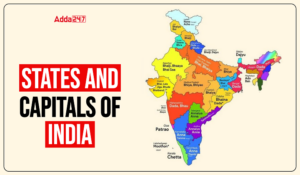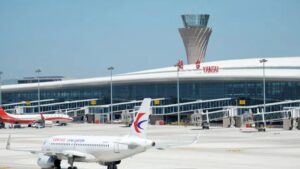Taiwan, also referred to as the Republic of China (ROC), is an island situated across the Taiwan Strait from mainland China. Since 1949, it has been run separately from the rest of China as the People’s Republic of China (PRC). The PRC declares that Taiwan will one day “unify” with the mainland and sees the island as a renegade province. Political leaders in Taiwan, an island nation with a democratically elected government and a population of 23 million, hold contrasting opinions about the status of the island and its ties to the mainland.
Buy Prime Test Series for all Banking, SSC, Insurance & other exams
China-Taiwan History:
- Since Taiwanese President Tsai Ing-victory wen’s in 2016, cross-strait tensions have risen. Tsai has rejected a plan that Ma Ying-jeou, her predecessor, supported in order to promote stronger ties across the Taiwan Strait.
- Beijing has been acting more and more aggressively in the meanwhile, including flying fighter jets close to the island. Some observers worry that a Chinese strike on Taiwan may lead to a conflict between the United States and China.
- Taiwan, also referred to as the Republic of China (ROC), is an island situated across the Taiwan Strait from mainland China. Since 1949, it has been run separately from the rest of China as the People’s Republic of China (PRC).
- The PRC declares that Taiwan will one day “unify” with the mainland and sees the island as a renegade province. Political leaders in Taiwan, an island nation with a democratically elected government and a population of 23 million, hold contrasting opinions about the status of the island and its ties to the mainland.
Does Taiwan belong to China?
- As per Beijing, Taiwan is a component of the “one China” that exists. It adheres to the “One-China principle,” according to which the PRC is the only legal government in China, and it wants Taiwan to eventually “unify” with the rest of the country.
- Beijing asserts that the 1992 Consensus, an agreement negotiated between representatives of the Chinese Communist Party (CCP) and the Kuomintang (KMT) party that ruled Taiwan at the time, binds Taiwan. This ‘agreement’ was never meant to settle the issue of Taiwan’s legal status, and the two parties disagree on its specifics.
- The 1992 Consensus is a consensus for the PRC that “the two sides of the strait belong to one China and will work together to seek national reunification,” according to Chinese President Xi Jinping.
- One China, different interpretations, according to the KMT, with the ROC serving as the “one China.”
China-Taiwan War 2022:
- The current situation makes the experts worry that if Chinese strike on Taiwan may lead to a conflict between the United States and China.
- The most recent trip to Taiwan by US Speaker Nancy Pelosi has heightened tensions between China and the US.
- China has denounced Pelosi’s travel and dubbed it extremely dangerous, pointing out that it is the highest-ranking visit by an American politician to Taiwan in the previous 25 years.
- As China perceives Taiwan as a breakaway province that would eventually come under Beijing’s rule, and as Taiwan regards itself as an independent nation with its own constitution and democratically elected authorities, tensions between the two nations—China and the US—have risen. China views US House Speaker Nancy Pelosi’s recent trip to Taiwan as an interference with its plans, and Beijing is not pleased.
Our delegation’s visit to Taiwan honors America’s unwavering commitment to supporting Taiwan’s vibrant Democracy.
Our discussions with Taiwan leadership reaffirm our support for our partner & promote our shared interests, including advancing a free & open Indo-Pacific region.
— Nancy Pelosi (@SpeakerPelosi) August 2, 2022
US and China at odds over Taiwan:
- The US has been balancing between Taiwan and China in a cautious manner. The “One-China” policy that Washington upholds recognises Beijing but permits informal relationships and defence cooperation with Taipei.
- The US gives armaments to Taiwan—by far the major arms supplier to Taiwan—and maintains strategic ambiguity regarding the extent to which it will be prepared to protect Taiwan from Chinese invasion.
- Tensions between the US and China appear to have increased recently. With 30 jets, including more than 20 fighters, breaching the area, China launched the second greatest intrusion into Taiwan’s air defence zone in 2022 in May, according to Taipei.
- Asked about China’s moves, US President Joe Biden indicated that if Taiwan were invaded, the US would intervene militarily.
About Taiwan:
- A hundred miles or so separate the island of Taiwan from the coast of South East China. The so-called “first island chain,” which encompasses a number of US-friendly nations that are also essential to US foreign policy, includes Taiwan.
- Some western scholars have said that if China were to annex Taiwan, it may be freer to project power throughout the Western Pacific and might even pose a danger to US military installations as far away is Guam and Hawaii. China, though, has claimed that its goals are only peaceful ones.
Significance of Taiwan to the rest of the world:
- The economy of Taiwan is quite significant. Taiwanese computer chips are used to power a large portion of the world’s common electronic devices, including computers, watches, and game consoles.
- According to one metric, the Taiwan semiconductor manufacturing company, or TSMC, controls more than half of the global market. A so-called “foundry,” such as TSMC, produces semiconductors with consumer and military input.
- It is a sizable sector with a 2021 market value of approximately $100 billion.
- Beijing may gain some control over one of the most significant businesses in the world if China invades Taiwan.
Conflict between China and the US over Taiwan:
- Experts say there is little reason to believe that the United States and China will start a full-fledged war over Taiwan.
- There is a lot of bluster, but William Choong, a senior fellow at the Indian Institute of Southeast Asian Studies, claims that if the Chinese intend to invade Taiwan thus close to the Ukraine crisis, they must be very careful about the gap.
- Additionally, compared to Russia, China’s economy is far more cut off from the world economy.
- The experts on international relations have also highlighted that when it comes to Taiwan, the US and China are both standing their ground. They must project a tough demeanour and avoid coming off as stepping back or rolling back.
- However, both the US and China are very careful not to start a direct flight. Both sides are attempting to mitigate the risk as they closely examine each other’s speech.
FAQs:
Ques: Does the US acknowledge Taiwan and China?
Ans. The United States acknowledged the Chinese view that there is only one China and that Taiwan is a part of China in the Joint Communiqué by recognising the Government of the People’s Republic of China as the only legitimate government of China.
Ques: What’s the Taiwan problem?
Ans. World War II, the Second Chinese Civil War (1945–1949), and the Cold War all had an impact on the debate over Taiwan’s political status. The fundamental question is who should be in charge of running the islands of Taiwan, Penghu, Kinmen, and Matsu.
Ques: Is Taiwan still a part of China?
Ans. After receiving Taiwan from Japan in 1945, the administration of the Republic of China retreated to Taiwan in 1949 with the intention of retaking mainland China. Both the ROC and the PRC continue to formally (and in their own constitutions) declare that Taiwan and mainland China are a part of their respective regions.
Ques: Is Taiwan regarded as an ally of the US?
Ans. Taiwan is an important U.S. partner in the Indo-Pacific due to its status as a leading democracy and a technical powerhouse. Despite the fact that the United States and Taiwan do not have diplomatic ties, our unofficial connections are strong.
Ques: Why hasn’t Taiwan declared itself independent of China?
Ans. The People’s Republic of China (PRC) government opposes Taiwanese independence because it considers Taiwan and mainland China to be separate parts of the same country.
Ques: Is China a NATO member?
Ans. No, China is not a NATO member. None of them are NATO members, but they are all cautious about China’s expanding influence and might. NATO has increased collaboration with its “Asia-Pacific partners,” which it refers to as the four Asian countries, since 2020.










 States and Capitals - How Many States in...
States and Capitals - How Many States in...
 Which is the Largest Hing Producing Stat...
Which is the Largest Hing Producing Stat...
 World’s Most Beautiful Airport of 2025 R...
World’s Most Beautiful Airport of 2025 R...

